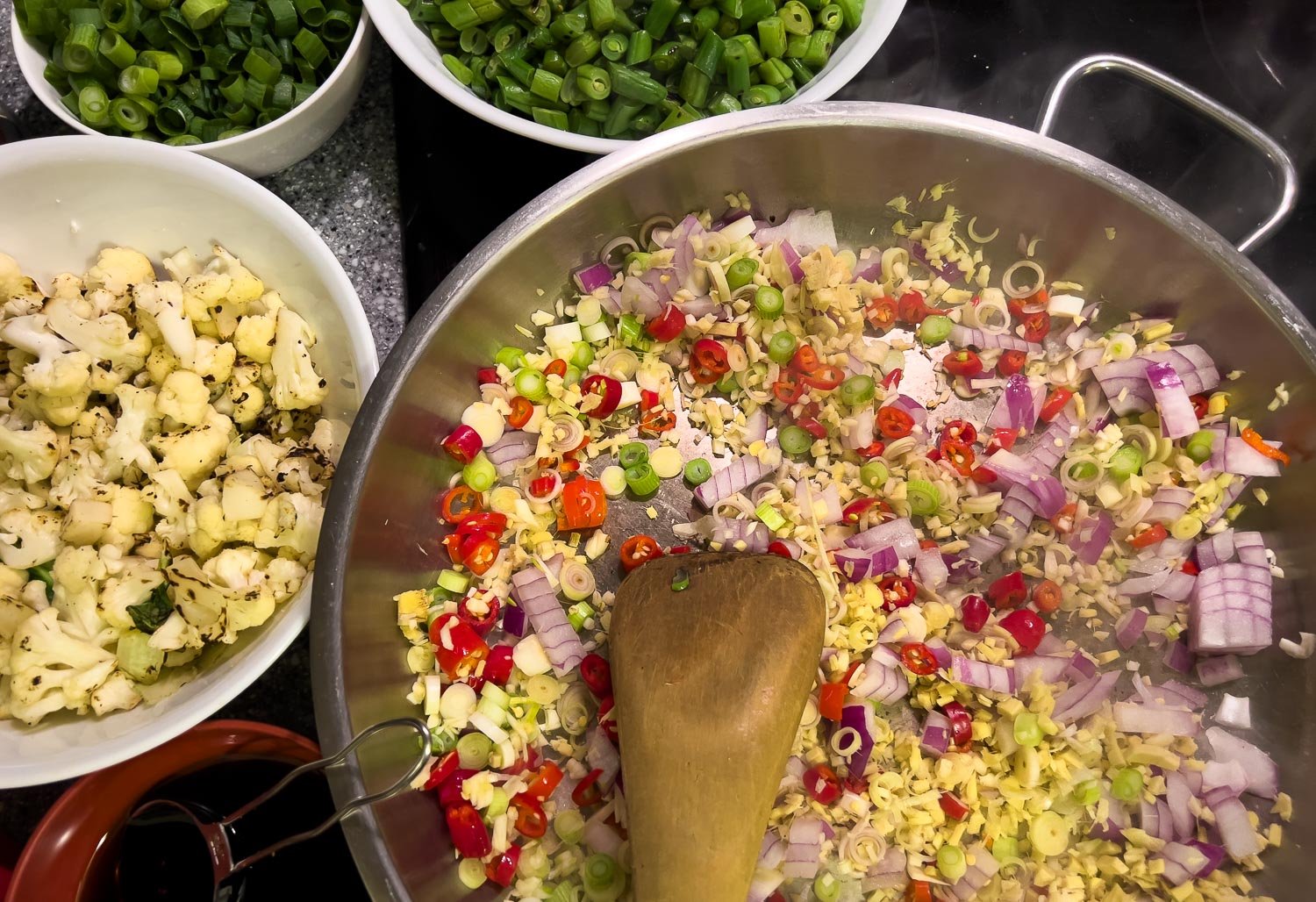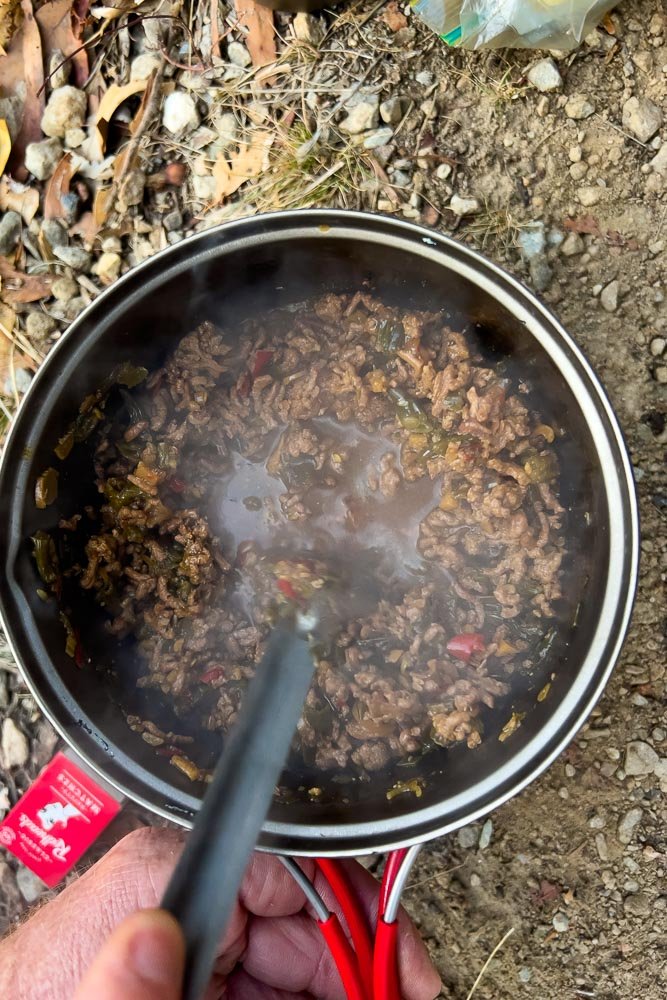Dehydrated Caramelised Pork Rice Bowl
This deliciously sticky Asian-style stirfry with rice or noodles is high in protein and carbs, and the caramelisation creates a wonderfully different texture to that of many other dehydrated dinners.
New flavours and textures in this yummy dehydrated Asian style dish. Grab a tomato and a few mini cucumbers for fresh bling!
This recipe is based on RecipeTinEats’ marvellous Vietnamese Rice Bowls and works equally well with TVP (Inga Aksamit of The Hungry Spork suggests that crumbled tempeh or firm tofu as a less processed alternative) or other mince such as chicken, beef or turkey. The full recipe makes 10-12 serves. Our 140g single portion serves (including rice) have 3050kJ with 36g of protein. We add a tablespoon of olive oil per two serves to finish the meat in camp, which takes the kJ per serve to 3450.
I love this recipe at home and wondered whether it was possible to adapt it for dehydration on the trail whilst still creating that sticky texture. The answer is a resounding yes, with a few tweaks in camp and with a little elbow grease on your pot afterwards (those with aluminium pots and variable gas flames have an advantage!). It’s worth it!
It tastes great just with meat and rice but, if you cook this recipe on the first night or two of your hike, you can add chopped tomato and cucumber for bright notes. Or dehydrate kimchi at home and cold soak/rehydrate it during the day while you’re walking. The recipe also works great with egg noodles or instant ramen.
Ingredients** (makes around 10 serves to fill a 9 tray Excalibur dehydrator, rice dried separately)
1.2 kg long grain or short grain rice*
430g cauliflower, stem chopped into 1cm dice and head separated into small florets
1.5 tbspns peanut or vegetable oil
1 knob garlic finely chopped
4 thumbs ginger, peeled and finely chopped
3 lemon grass, white part only, finely chopped then pounded in a mortar and pestle
60g birdseye or mild chillies to taste, finely sliced
3 large onions finely diced
1.5kg lean pork mince
660g green beans, sliced into 1cm pieces
1 cup firmly packed brown sugar
6 tbspns fish sauce or to taste
6 spring onions finely sliced
*Both work though I find the texture of long grain rice is easier to get right in camp. However, if you prefer the sticky, clumpy effect, go for short grain.
** The total amount in this recipe makes around 30,500kJ with 356 g of protein. Divide by the number of serves you portion to calculate individual serving size nutrition.
Method
If you are making this full recipe, parcook and dehydrate the rice on day one, and cook and dehydrate the meat and vegetables on Day 2. Package on Day 3.
To parcook the rice, use about two thirds the amount of water recommended for absorption method. Turn off heat as soon as the bottom of the pot is dry. Shake the pot vigorously to loosen rice or separate with a fork, cover again and allow to steam for twenty minutes. Place one or two serves into bowls to judge amount, then spread those onto a tray marked with a teaspoon. Spread the rest onto trays and dehydrate at 63C/145°F.
Preheat oven to 190C/375°F. Spread cauliflower onto a baking tray and place into the hot oven for 15-20 minutes or until slightly softened and beginning to char or brown on the edges.
Meanwhile, stir fry green beans in a splash of oil in a hot wok until bright green and with slight char marks. Remove and set aside. Wipe out wok.
Return to heat and add half to one tablespoon of oil; you can get away with less in a nonstick pan or wok. Stirfry aromatics (ginger, garlic, lemongrass, chilli, onion) over medium to high heat until softened and fragrant.
Add pork mince: you may need to do this in batches. Stir fry over high heat until broken up and pale throughout, with no hint of red. Add sugar and most of the fish sauce. Stir until well-distributed, then let sit for a minute to caramelise on the bottom. Stir, scraping pan, and let sit again. Do this a few times until the meat is nicely sticky and caramelised and any excess liquid has evaporated.
Add cauliflower, beans and spring onion and mix well. Taste, add more of the fish sauce if necessary.
Spoon one portion of your meat mix into a bowl: this is your one serve — remember, you will be adding rice! Place onto a dehydrator tray marked with a teaspoon. Spread remaining mix onto trays and dehydrate at 69C (156F) until completely dry, breaking up clumps regularly.
When you mix the beans and cauliflower with the mince, a little moisture may come out of the vegetables and dissolve some of the sticky yum. If this happens, place your mix into a colander and collect any liquid before spreading meat mix on dehydrator trays. There shouldn’t be much liquid but, if there is, return it to the wok and boil a few minutes to thicken before spreading. Spread the liquid onto a silicone sheet and dry with the meat. Powder the resulting bark in a spice grinder, then put into a bowl.
Packaging for Two:
Portion out your dehydrated rice and fold into baking paper or put into a ziploc. Alternatively, if using noodles, wrap in baking paper or place in a ziploc. We package 140g of rice or noodles for two.
When the meat mix is dry, weigh the mix on your marked tray: this is one serve DRY WEIGHT. Normally, we would substract wet and dry weights to get the exact amount of water you need to add when rehydrating, but this recipe seems to work better by eye.
For two, place two serves (dry weight x 2) into a vac seal bag. Repeat with remaining meat mix. You may have a little left over, which you can spread across the bags. If you have any powdered sauce, distribute it evenly across the bags.
Add your rice or noodles to the vac seal bag, vac and seal. Par vac noodles or they will get crushed.
In Camp
Geoff and I don’t carry bowls or plates: one eats out of the sous vide bag, the other out of the pot. The following technique works for rehydrating the rice and meat separately if you are like us.
Carefully slit open your bag and remove the rice pack. Empty meat mix into your pot and cover VERY scantly with water. Cover and bring to the boil. Remove from heat and transfer meat mix to sousvide bag. Seal with a peg or slider and place in a cosy for twenty minutes (alocohol stove) or 25 minutes (gas stove).
After 15 0r 20 minutes, put rice in pot, cover scantly with water and bring to the boil. Stir, remove from heat and let sit covered for five minutes (in a pot cosy if you have one). Parcooked dehydrated rice rehydrates very quickly, within minutes. Transfer your rice to your mug and/or pot lid and/or ziploc bag. Wipe out your pot.
Add a little oil to your pot and put it on a medium flame. Return the rehydrated meat and veg mix to pot.
Stir the meat mix, scraping the bottom as the scant remaining liquid evaporates. It will start to catch and stick, but this is what you want. Take it as far as you and your pot dare, then remove from heat.
Reducing the liquid. In subsequent batches, we used less.
You can place your rice into the sousvide bag while the meat is caramelising, but it’s pretty quick, just a few minutes even on an alcohol stove — we don’t bother. Alternatively, if that’s all too much faffing about, just cook and rehydrate your rice first, keep it warm for 20 mins in your jacket, and do the meat jmix straight afterwards.
Push meat to one side and return rice to pot. For two, remove half the meat into the sousvide bag, then return half the rice to the pot. Place the other half into the sousvide bag. If you are carrying a tomato and/or a couple of mini cucumbers, chop them and place on top.
We have a caldera cone alcohol stove system, which throws flame up the side of our titanium 1300ml pasta pot; a simmer ring may be helpful if your stove has one. The sides and bottom do burn easily on titanium pots: you will definitely need a scourer afterwards! Another trick is to rinse your pan, then add a spoonful of clean sand or soil (taken from below the soil surface) to the pot before using your scourer. In our experience, “non stick” backpacking pots are pretty useless. Aluminium is a better option.
Adjustable gas stoves are easier to use with this recipe, but upright integrated canister stoves like Jetboils tend to have a very small bottom surface area and you will struggle to caramelise the meat in a tall narrow pot.
Delicious even without the tomato and cucumber! An Asian stirfry winner on trail!








